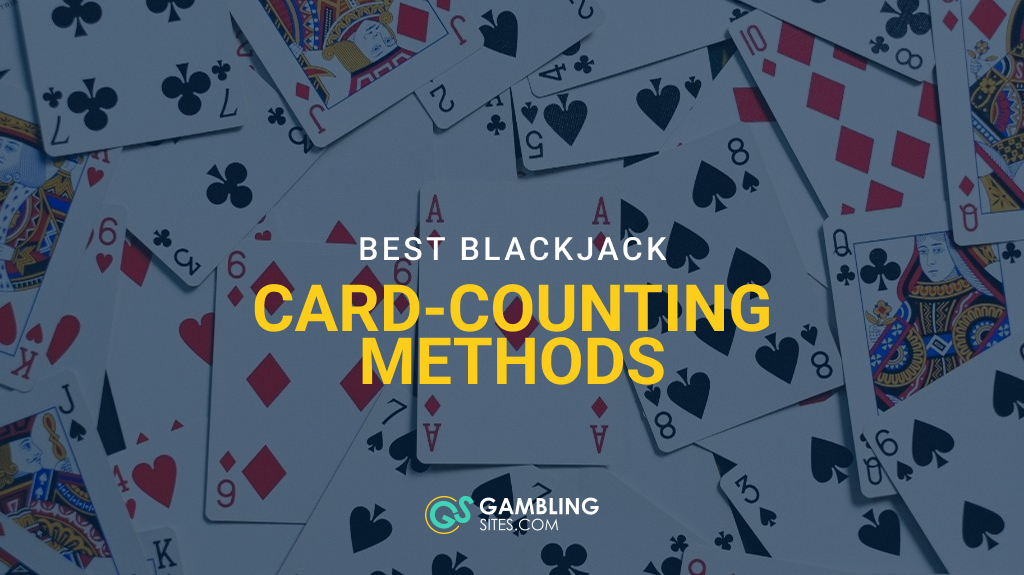Best Blackjack Card-Counting Methods: Hi-Lo, KO, Omega II & More

Card counting in blackjack is a powerful strategy that can shift the house edge anywhere from 0.5% to 1.5%, depending on the system, rules, and player skill. While casinos use countermeasures to spot skilled players, card counting is still viable for players who practice and play with discipline.
We’ll break down five popular systems: Hi-Lo, KO, Ace/Five, Hi-Opt I, and Omega II. Each system has their own sets of unique benefits and challenges, and understanding these methods can help you approach blackjack with greater strategy and confidence.
Top 5 Blackjack Card Counting Systems Compared
Picking the right card-counting system depends on factors like difficulty, betting correlation, and learning curve. If you’re new to card counting, start with a beginner’s guide on how to count cards in blackjack before comparing advanced systems.
| System Name | Difficulty Level | Betting Correlation | Playing Efficiency | Learning Time |
|---|---|---|---|---|
| Hi-Lo | 2 | High | Good | Moderate |
| KO | 1 | Moderate | Fair | Short |
| Ace/Five | 1 | Low | Basic | Very Short |
| Hi-Opt I | 3 | High | Excellent | Long |
| Omega II | 4 | Very High | Superior | Extensive |
Hi-Lo System
The Hi-Lo system is the most widely used card-counting method, valued for its balance of simplicity and effectiveness. In Hi-Lo, assign each card a value: +1 for 2-6, 0 for 7-9, and -1 for 10, Jack, Queen, King, and Ace. As cards are dealt, maintain a running count by adding or subtracting these values. The Hi-Lo system is a balanced count, meaning the sum of all card values in a full deck equals zero.
This allows players to convert the running count to a “true count” by dividing by the number of decks remaining, which is essential for accurate betting and playing decisions. Hi-Lo is usually recommended as the entry point for aspiring card counters.
Hi-Lo Card Counting Flow
- Cards Dealt
↓ - Assign Values
- 2–6 = +1
- 7–9 = 0
- 10, J, Q, K, A = −1
↓
- Running Count
Add or subtract values as cards appear.
↓ - Estimate Decks Remaining
(Roughly judge how many decks are left in play.)
↓ - True Count
Running Count ÷ Decks Remaining = True Count
↓ - Decisions
- Raise bets when the True Count is high.
- Adjust plays using strategy deviations.
- Keep your play natural to avoid detection.
KO (Knock-Out) System
The KO (Knock-Out) system is designed for simplicity, removing the need for true count conversion. In KO, cards 2-7 are assigned +1, 8-9 are 0, and 10-Ace are -1. Unlike Hi-Lo, KO is an unbalanced system and the sum of all card values in a deck does not equal zero. This feature eliminates the need to adjust for the number of decks remaining, making KO easier to use in fast-paced games or for beginners. However, the lack of true count conversion can slightly reduce betting accuracy compared to balanced systems.
KO Card Counting Flow
- Cards Dealt
↓ - Assign Values
- 2–7 = +1
- 8–9 = 0
- 10, J, Q, K, A = −1
↓
- Running Count
Add or subtract values as cards appear.
↓ - No True Count Needed
KO is an unbalanced system. Totals don’t return to zero, so you don’t divide by decks remaining.
↓ - Decisions
- Watch for the “pivot point” (the running count where the player has an edge).
- Increase bets once the pivot is reached or exceeded.
- Keep play natural to avoid detection.
Ace/Five Count
The Ace/Five count is one of the simplest card-counting systems, ideal for casual players or those new to card counting. Only Aces and Fives are tracked: add +1 for each Five and -1 for each Ace. This system is most effective in single-deck games, where the simplicity can outweigh its lack of precision. While the Ace/Five count does not provide as much advantage as more sophisticated systems, it offers an easier introduction to card counting and basic advantage play.
Ace/Five Card Counting Flow
- Cards Dealt
↓ - Assign Values
- Five = +1
- Ace = −1
- All other cards = 0
↓
- Running Count
- Add +1 each time a Five appears.
- Subtract −1 each time an Ace appears.
↓
- Betting Decision
- If the running count is positive (greater than 0) → increase bets slightly.
- If the running count is 0 or negative → keep bets at the table minimum.
↓
- Why It Works
- Fewer Fives = stronger deck for the player (helps with 10-value hands and blackjacks).
- Fewer Aces = weaker deck (harder to hit blackjacks).
↓
- Key Notes
- Works best in single-deck games.
- Very simple but offers only a small edge compared to advanced systems.
- Great as an introductory system for learning card counting basics.
Hi-Opt I
Hi-Opt I (High-Optimum I) is an advanced, balanced card-counting system that offers higher playing efficiency than Hi-Lo. In Hi-Opt I, 3-6 are counted as +1, 2, 7, 8, 9, and Ace are 0, and 10, Jack, Queen, and King are -1. Notably, Aces are not counted, which means players must keep a separate side count of Aces to maximize betting correlation. Hi-Opt I is best suited for experienced counters who are willing to invest the time to master its nuances and side-counting requirements.
Hi-Opt I Card Counting Flow
- Cards Dealt
↓ - Assign Values
- 3–6 = +1
- 2, 7, 8, 9, Ace = 0
- 10, J, Q, K = −1
↓
- Running Count
- Add +1 for low cards (3–6).
- Subtract −1 for high cards (10–K).
- Ignore 2, 7, 8, 9, and Aces in the main count.
↓
- Side Count of Aces
- Track Aces separately (since they are not part of the main count).
- Use Ace tracking to refine betting and playing decisions (especially for blackjacks).
↓
- True Count Conversion
- Divide the running count by the number of decks remaining.
- Apply Ace side count adjustments as needed.
↓
- Decisions
- Increase bets as the True Count rises, factoring in Ace availability.
- Use deviations for playing decisions when the count signals an advantage.
↓
- Key Notes
- Balanced system: totals return to zero per deck.
- Higher playing efficiency than Hi-Lo.
- Best for experienced counters who can manage side counts without error.
Omega II
Omega II is a complex, multi-level balanced system favored by professional card counters for its superior accuracy and high betting correlation. Card values in Omega II are as follows: 2, 3, and 7 are +1; 4, 5, and 6 are +2; 8 and Ace are 0; 9 is -1; and 10, Jack, Queen, and King are -2. Like Hi-Opt I, Omega II benefits from a side count of Aces to further improve betting accuracy. Because of its complexity and the need for precise execution, Omega II is recommended only for highly skilled and dedicated players.
Omega II Card Counting Flow
- Cards Dealt
↓ - Assign Values
- 2, 3, 7 = +1
- 4, 5, 6 = +2
- 8, Ace = 0
- 9 = −1
- 10, J, Q, K = −2
↓
- Running Count
- Add or subtract values as cards are revealed.
- Note: Higher positive counts indicate a deck richer in 10-value cards.
↓
- Side Count of Aces
- Track Aces separately for more accurate betting decisions.
- This improves correlation with blackjack payouts.
↓
- True Count Conversion
- Divide the running count by the number of decks remaining.
- Adjust with the Ace side count for maximum precision.
↓
- Decisions
- Increase bets when the True Count is high.
- Apply advanced deviations from basic strategy when the count signals a strong edge.
↓
- Key Notes
- Balanced system (totals return to zero per deck).
- Complex, multi-level values make it harder to master.
- Recommended only for highly skilled, experienced counters.
Choosing the Right System
When selecting a card-counting system, consider the following:
System Selection Guide
Choosing the right system depends on your experience and goals. Here’s a guide to help you decide:
| Player Type | Recommended System | Reasoning |
|---|---|---|
| Casual Player | Ace/Five | Simple and easy to learn |
| Beginner | KO | Straightforward with no true count needed |
| Intermediate | Hi-Lo | Balanced efficiency and difficulty |
| Experienced | Hi-Opt I | High efficiency with moderate complexity |
| Professional | Omega II | Maximum accuracy for seasoned counters |
Practice and Implementation of Card Counting in Blackjack
Building card-counting skill takes more than just understanding the numbers, it requires structured practice, awareness of common mistakes, and clear goals to measure progress.
Training Methods
To master card counting, consistent practice is key. Here are some recommended techniques that can help you hone your card counting skills:
- Single deck drills: Practice tracking the count through a single deck to develop accuracy.
- Speed counting exercises: Time yourself to improve speed and maintain accuracy under pressure.
- Online training tools: Use apps and software that simulate real blackjack games for practice.
- Real-world simulation: Apply your skills in low-stakes or practice games to gain experience. Many online casinos offer low stakes games for you to practice counting cards in live dealer blackjack.
Common Mistakes to Avoid
It’s easy to make mistakes when card counting, and a single mistake will ruin your flow in a shoe. To improve your card-counting skills, avoid these common pitfalls:
- Losing track of the count: Stay focused and practice regularly to maintain accuracy.
- Misjudging betting correlation: Understand the strengths and limitations of your chosen system.
- Overestimating skill level: Begin with simpler systems and progress as your proficiency increases.
Success Indicators
Monitor your progress with these benchmarks:
- Accuracy benchmarks: Consistently maintain the correct running count through a full deck.
- Speed targets: Aim to count down a deck in under 30 seconds.
- Practical application metrics: Successfully implement your system in live or simulated games.
Elevating Your Blackjack Game
Card counting can level up your blackjack experience, offering both an intellectual challenge and the potential for profit. Review the systems, practice makes perfect, and select a method that aligns with your goals and abilities. Begin with simple exercises and gradually up the difficulty as your skills improve. With proper dedication, discipline, and the best blackjack strategy, you can significantly enhance your advantage at the table.
Please note that all comments are moderated in accordance with the GamblingSites.com house rules.
 80%
80% 75%
75%

Card counting is real thing , it actually works . If done perfectly helps you beat tye blackjack game and play an edge against tge house . Takes but time to practise but works certainly . My own experience.
All of the card-counting systems that are designed for Blackjack are feckless and inutile. If they are so effective,why are they being broadcasted? And why do those designers resort to publishing books about the systems instead of using them to prolificly play Blackjack? All those systems are paltry approximating rubbish.